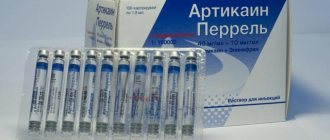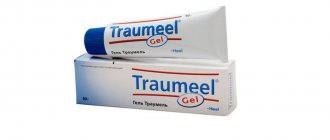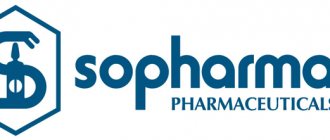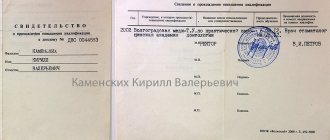Pharmacological authorities
Pharmacodynamics.
Lincomycin is an antibiotic of the lincosamide group, a product of the life of Streptomyces lincolniensis.
It inhibits the protein synthesis of bacteria due to the reverse binding to the 50S subunit of ribosomes, disrupting the formation of peptide bonds.
Depending on the sensitivity of microorganisms and the concentration of the antibiotic, lincomycin can exhibit both bacteriostatic and bactericidal activity. Spectrum of activity in vitro
includes a number of alarms:
Sensitive microorganisms (minimum inhibitory concentration (MIC) ≤ 2 µg/ml):
- anaerobic gram-positive bacteria that do not incubate spores, such as Propionibacterium spp., Eubacterim spp.,
as well as
Actinomyces spp.
; - anaerobic and microaerophilic gram-positive cocci, including Peptococcus spp., Peptostreptococcus spp.
and microaerophilic streptococci; - Aerobic gram-positive microorganisms, including staphylococci, streptococci (including S. faecalis
) and pneumococci
Microorganisms with moderate sensitivity (MIC becomes 2–4 μg/ml):
- anaerobic gram-negative bacteria that do not resolve spores, such as Bacteroides spp., Fusobacterium spp.;
- anaerobic gram-positive bacteria that induce spores, called Clostridium spp
.
Resistant microorganisms or microorganisms with low sensitivity (MIC ≥ 8 μg/ml), including Streptococcus faecalis, Neisseria,
Most strains of
Haemophilus influenzae, Pseudomonas
and other gram-negative microorganisms.
I want bacteria of the genus Shigella
resistant
in vitro
to lincomycin (MIC is approximately 200–400 μg/ml), lincomycin is effective when the disease is in contact with the fact that even a high level of lincomycin reaches the intestine (approximately 3000–7000 µg/g viper).
Cross-resistance between clindamycin and lincomycin was established. Most often, resistance is due to the methylation of specific nucleosides in the 23S RNA subunit of the 50S ribosomal subunit, which may result in cross-resistance to macrolites and streptogramin B (MLSB phenotype). Macrolyte-resistant isolates of these microorganisms should be tested for inducible resistance to lincomycin/clindamycin using an additional D-test or other suitable method. At this time, there are no criteria for interpreting the results of the lincomycin sensitivity test.
Pharmacokinetics.
Soaked up.
Internal ulcerative administration of a single dose of 600 mg can reduce the mean maximum level of blood syringation to 11.6 mcg/ml after 1 year and maintain therapeutic levels lasting 17–20 years for the most part. and sensitive gram-positive microorganisms.
With internal infusion of lincomycin 600 mg for a period of 2 years, the mean maximum concentration in blood sirovation reaches 15.9 mcg/ml, which maintains therapeutic levels and continued for 14 years for most sensitive gram-positive microorganisms.
Rozpodil.
On the basis of direct and indirect signs, it was established that binding to blood proteins decreases with increased concentration in serum (intensified binding to plasma proteins).
In the blood of the fetus, in the peritoneal and pleural regions, concentrations can reach 25–50% of the level in the blood, in maternal milk the indicator becomes 50–100%, in cystic tissue - close 40% in extra soft fabrics – 75%.
At the same time, lincomycin penetrates completely into the spinal cord (1–18% of the level in the blood); in patients with meningitis, the level in the liquor reaches 40% of the level in the blood.
Vivedennya.
A significant part of the drug is metabolized, metabolism is carried out mainly by the liver. The normal gestation period is 5.4 ± 1 year. However, this period may be delayed due to impaired liver function and/or poor functioning. In connection with this, it is necessary to change the frequency of administration of lincomycin to patients with impaired liver function or dysfunction.
After internal administration of 600 mg, the excretion of bacteriologically active drug in the sample becomes 1.8–24.8% (in the average – 17.3%), and in the empty one – 4–14%. After intravenous administration of 600 mg over a period of 2 years, the excretion of bacteriologically active drug in the section becomes 4.9–30.3% (in the average – 13.8%). The medicinal purpose appears to be in the form of bacteriologically inactive metabolites. Hemodialysis and peritoneal dialysis do not affect the excretion of lincomycin from the blood.
Instructions for use, radar, prescription medicine on Medicines.mi
On the Medicines.mi website you will find the latest information about medicines, instructions for the use of medicines and homeopathic medicines, as well as recipes for medicines (RDS) and biological food additives (BAA).
Homeopathy
Homeopathy is a type of alternative medicine that involves the use of highly diluted drugs that cause symptoms in healthy people similar to those of the patient's illness. The concept of treatment based on the principle of “like is like” (lat. similia similibus curantur) is opposed by homeopaths to the principles of rational pharmacotherapy. The founder and author of the term is the German physician Christian Friedrich Samuel Hahnemann (1755-1843). The process of dilution, reducing the concentration of the original substance in homeopathy is called “potentization” or “dynamization”. This name emphasizes that, according to Hahnemann's belief, dilution accompanied by shaking (or rubbing for insoluble substances such as quartz or oyster shells) activates the “vital energy” of the diluted substance and enhances (“potentiates”) its healing properties...
MORE ABOUT HOMEOPATHY...
dietary supplements
Biologically active food additives (BAA) are compositions of biologically active substances intended for direct intake with food or inclusion in food products.
The term nutraceuticals was coined by Dr. Steven de Felice, founder and chairman of the Foundation for Innovation in Medicine (FIM), in 1989 to describe food and pharmaceutical products.
Biologically active food supplements, along with specialized food products, are the most effective way to eliminate vitamin deficiency, but provided that they contain biological substances in doses that meet the physiological needs of a person.
MORE ABOUT DIET SUPPLEMENTS...
Medications
Medicine, medicinal product, medication, medicine (novolat. praeparatum medicinale, praeparatum pharmaceuticum, medicamentum; slang. medicinal product) - a substance or mixture of substances of synthetic or natural origin in the form of a dosage form (tablets, capsules, solution, ointment, etc. .), used for the prevention, diagnosis and treatment of diseases.
Before being used in medical practice, medicines must undergo clinical trials and receive permission for use.
Fragment of the Ebers papyrus, which contains 877 drug recipes
Already in ancient times, people tried to save their lives using various natural medicinal substances. Most often these were plant extracts, but preparations were also used that were obtained from raw meat, yeast and animal waste. Some medicinal substances are available in easily accessible form in plant or animal raw materials, and therefore medicine has successfully used since ancient times a large number of drugs of plant and animal origin (for example, castor beans, opium, sea onions, known in ancient Egypt; mercury, known to the ancient Hindus; foxglove, lily of the valley, adonis and many others, widely used in traditional medicine)…
MORE ABOUT MEDICINES...
It should be cautioned that the properties declared by the manufacturer of medicines, homeopathic preparations and/or dietary supplements often do not meet the criteria of evidence-based medicine, or the level of evidence from testing these drugs is extremely low.
Levels of evidence-based medicine:
- Class (level) I (A) large double-blind placebo-controlled studies, as well as data obtained from meta-analysis of several randomized controlled trials.
- Class (level) II (B) small randomized and controlled studies in which statistical data are based on a small number of patients.
- Class (level) III (C) non-randomized clinical trials on a limited number of patients.
- Class (level) IV (D) development by a group of experts of consensus on a specific problem.
The information on the site is intended for the information of healthcare professionals only and does not constitute a guide to treatment.
The current version of the prescription drug (RP), homeopathic drug or dietary supplement is always included in the package with the drug. The relevance of the instructions for use on our website is not controlled in any way.
Before using any of the drugs, you must consult a specialist! It is prohibited to use drugs without consulting a specialist!
Please note: this information may not be current at the time you read it. Always look for the latest versions of the radar in the package with the drug. It is prohibited to use site materials without consulting a specialist.
Up
Tags:
Comments:
Features of good stagnation
Lincomycin should not be administered internally as a bolus of undiluted drug. Internally, the drug can be administered via intravenous drip infusion for at least 1 year (section “Method of administration and dosage”).
Prescribed to Lincomycin-Darnitsa for various types of confirmed or suspected high-virality bacterial infection is unlikely to be harmful for the patient and predisposes the patient to illness. removal of bacteria from resistance to medicinal use.
To prevent the development of aseptic necrosis, internal ulcer injections are carried out deep into the meat.
Stagnation of antibiotics is often accompanied by the development of diarrhea, which is likely to end after antibiotic therapy is started. However, after initiating antibiotic therapy, patients may be wary of watery or bloody vomiting, which may or may not be accompanied by abdominal cramps, elevated body temperature, and headaches. Refer 2 or more months after taking the remaining dose of the antibiotic. In such a situation, the patient's symptoms will soon go to the doctor.
Severe infections may require further incision and drainage or modification of other indicated procedures in addition to antibacterial therapy.
It is necessary to conduct microbiological studies to determine the sensitivity of the organism to lincomycin.
Necessary surgical procedures should be carried out in patients receiving antibiotic therapy.
The effectiveness of staphylococcal lincomycin for the treatment of staphylococcal infections resistant to other antibiotics and sensitive to lincomycin has been demonstrated. If strains of staphylococci resistant to lincomycin have been identified, it is necessary to carry out bacteriological cultures and monitor the sensitivity of the individuals in those infected with therapy with lincomycin-Darnitsa. Sometimes the stagnation of macrolides may result in partial, rather than complete, overresistance. Whenever a drug is indicated, it can be combined with other antibacterial agents.
The use of lincomycin for the treatment of minor bacterial infections and viral infections is not indicated.
By reducing the fluidity of drug-resistant bacteria and preserving the effectiveness of lincomycin and other antibacterial drugs, lincomycin-Darnitsa is then frozen for disinfection or prevention of infections caused by susceptible bacteria. If the results of bacteriological cultures and sensitivity are significant, they must be treated promptly when choosing or changing antibacterial therapy. Given the presence of such data, empirical choice of therapy should be based on local epidemiological data and local characteristics of sensitivity.
Risk of colitis.
Due to the risk of development of pseudomembranous colitis associated with congestion of antibacterial agents, before making a decision to prescribe lincomycin, the doctor may analyze the nature of the infection and assess the possibility of congestion. h toxic alternative drugs (for example, erythromycin).
Medical advice should be taken to treat patients with gastrointestinal illnesses and colitis with caution.
Treatment with antibacterial drugs may lead to disruption of the normal flora of the large intestine and may stimulate the overgrowth of clostridia. Research has shown that the toxin is produced by Clostridium difficile
, is the main cause of antibiotic-associated colitis.
Immediately after the initial diagnosis of pseudomembranous colitis is made, a scan is performed. In cases of pseudomembranous colitis of the mild stage, it is necessary to take proper medication. At levels of severity from moderate to severe, treatment is carried out with the introduction of electrolytes, proteins and antibacterial agents that are effective against Clostridium difficile
in colitis.
Clostridium difficile
-associated diarrhea (ADAD) has been associated with exposure to many of the antibacterial drugs, including lincomycin, and ranges in severity from mild diarrhea to fatal colitis.
Treatment with antibacterial drugs destroys the normal flora of the small intestine, which leads to the growth of Clostridium difficile
.
Residues from lincomycin treatment are associated with the development of severe colitis, which can be fatal and may result in severe infections unless less toxic antimicrobial agents are used. This should not be avoided in patients with non-bacterial infections, such as most infections of the upper respiratory tract.
Clostridium difficile
produces toxins A and B, which inhibit the development of CDAD.
Clostridium difficile
strains that produce a hypertoxin are associated with increased morbidity and mortality, although the infection may be refractory to antibacterial therapy and require colectomy. In patients who develop diarrhea after taking antibiotics, a diagnosis of CDAD should be considered. Also, a detailed history taking was necessary, and the findings of the BPAD were recorded 2 months after the initiation of antibacterial drugs.
In cases of suspected or confirmed CDAD, it is more precise to treat with an antibacterial agent that is not directly against Clostridium difficile,
need to be pinned.
Clinical indications are followed by the following: stagnation of electrolytes, supplementary administration of proteins, antibacterial treatment of Clostridium difficile
and surgical evaluation.
Allergy.
Linkomycin-Darnitsa should be used with caution in patients with a history of severe bronchial asthma or severe allergies, or atopy.
Hypersensitivity.
During the period of lencomycin stagnation, the development of serious hypersensitivity reactions, including anaphylactic reactions and severe side effects such as Stevens-Johnson syndrome, toxicity, was reported. epidermal necrolysis, acute generalization, exanthematous pustulosis and erythema multiforme. If an allergic reaction to lincomycin develops, treatment should be initiated and a similar therapy should be initiated (section “Adverse reactions”).
Meningitis.
Regardless of the fact that lincomycin penetrates into the cerebrospinal region (CSR), the level of lincomycin in the CSR may be insufficient for the treatment of meningitis, so medicinal benefit cannot be prescribed in such episodes.
Superinfections.
Congestion of lincomycin can lead to excessive growth of insensitive organisms, such as yeast fungi. In the event of a superinfection, the trace should be taken from the following visits, the indications are consistent with the clinical situation. If treatment with lincomycin is required in patients with already obvious fungal infections, it is necessary to immediately carry out antifungal therapy.
In patients with severely impaired function, the period of withdrawal of lincomycin from blood serum may be similar to patients in whom the function is not impaired. In patients with impaired liver function, the period of recovery from blood serum may be twice as long as in patients with normal liver function.
For patients with severely impaired liver function, it is necessary to carefully select the dose of the drug and monitor the level of lincomycin in blood serum levels during therapy. ї high doses of medicinal drugs.
Before the end of the bath, it is necessary to periodically perform liver function tests and blood tests.
Zastosuvannya for summer people.
Accumulations to date show that a subgroup of older patients with severe illnesses is susceptible to diarrhea. If medication is prescribed to patients in this group, it is necessary to carefully monitor changes in their frequency of voiding.
Pediatric stasis.
Premature babies are more susceptible to developing toxicity.
Important information about additional speeches.
It is advisable to avoid sodium, so patients who are on a controlled diet instead of sodium should be careful when it becomes dehydrated.
Suspension during pregnancy or breastfeeding.
The teratogenic potential of lincomycin has not been assessed in animals or adequately monitored with adequate peer control before infusing lincomycin into pregnant women. Lincomycin should not be used during pregnancy, other than during periods of pregnancy, unless treatment is absolutely necessary.
The presence of lincomycin in human breast milk was reported at concentrations ranging from 0.5 to 2.4 mcg/ml. Due to the possible occurrence of serious adverse reactions to lincomycin in infants who are undergoing breast baths, it is necessary to take a decision to thoroughly bathe the breasts or apply baths promptly against the use of measles medicine. whoever I want for my mother.
This is due to the fluidity of the reaction during treatment with vehicles or other mechanisms.
There was no particular influence on the fluidity of the reaction during caravanning by motor transport or other mechanisms, but there was information about the episodes of guilt-related congestion.
Method of congestion and dosage
Lincomycin should not be administered internally as a bolus of undiluted drug. Internally, the drug can be administered via intravenous infusion and drip infusion for at least 1 year.
During the course of therapy, severe diarrhea develops, which can lead to the accumulation of antibacterial agents.
Grown up.
Internal language introduction.
The initial dose is:
600 mg internal dermal 24 years.
Severe infections: 600 mg intradermal for 12 years (or more often), which indicates the severity of the infection.
Internal administration.
The initial dose is:
Vid 600 mg to 1 g skin 8–12 years.
In case of severe infections, the dose may be increased.
In situations where there is a threat to life, the dosage for intravenous administration can be up to 8 g.
Children (1 month old).
Internal language injection.
10 mg/kg per dose for 1 injection.
Severe infections: 10 mg/kg skin for 12 years or more often.
Internal influences.
10 to 20 mg/kg per dose, depending on the severity of the infection, can be administered in a number of doses consistent with the descriptions of the rules of dilution and speed of infusion.
Dosage for patients with impaired liver function or low.
In patients with impaired liver function, the period of administration of lincomycin from the blood serum increases slightly, which is a basis for reducing the frequency of administration of lincomycin. While lincomycin therapy is necessary for patients with significant impairment of function, the appropriate dose should be 25% to 30% of the dose recommended for patients with normal function. nirok.
The severity of the treatment is determined individually.
Infections caused by β-hemolytic streptococcus.
Likuvanna may last for at least 10 days.
Dilution and fluidity of infusion.
The dose for administration in the form of infusion is calculated as follows:
1 g of lincomycin should be diluted with at least 100 ml of the standard dilution solution (0.9% sodium chloride dilution), whereby the duration of the infusion will not be less than 1 year.
| Dose | Volume of allowance for dilution | Trival of infusion |
| 600 mg | 100 ml | 1 year |
| 1 g | 100 ml | 1 year |
| 2 g | 200 ml | 2 years |
| 3 g | 300 ml | 3 years |
| 4 g | 400 ml | 4 years |
The prescribed dose can be administered repeatedly, the frequency of administration is determined according to consumption, in which case the additional dose may not exceed the maximum recommended dose of lincomycin, which becomes 8 g.
Note
. Severe reactions in the cardiovascular and respiratory systems may occur if this drug is administered at higher concentrations than recommended and with greater fluidity.
Children
.
Linkomycin-Darnitsa should be administered to children over 1 month of age at the recommended doses (section “Method of administration and dosage”).
pharmachologic effect
The antibiotic produced by Streptomyces lincolniensis has a bacteriostatic effect.
Sensitive in vivo: Staphylococcus aureus (penicillinase-producing and non-producing strains), Streptococcus pneumoniae. Sensitive in vitro: Aerobic gram-positive cocci - Streptococcus pyogenes, Streptococcus spp. viridans group. Aerobic gram-positive rods - Corynebacterium diphtheriae. Anaerobic gram-positive non-spore-forming rods - Propionibacterium acnes. Anaerobic gram-positive spore-forming rods - Clostridium tetani, Clostridium perfringens.
Ineffective against most strains of Enterococcus faecalis; does not affect Neisseria gonorrhoeae, Neisseria meningitidis, Haemophilus influenzae and other gram-negative bacteria; fungi and viruses. The optimum action is in an alkaline environment (pH 8-8.5).
Resistance to lincomycin develops slowly. In high doses it has a bactericidal effect.
Overdose
In cases of overdose, secondary gastrointestinal disorders may occur, including abdominal pain, nausea, vomiting and diarrhea. Descriptions of severe reactions in the side of the heart-legene system after rapid intravenous administration of undiluted high doses. Such reactions were not to blame, since the medicinal use of dilutions followed the recommendations.
Likuvannya
overdosage may be for the additional help of shlunik lavage or provoking vomiting. The specific antidote is unknown.
Hemodialysis and peritoneal dialysis are ineffective for removing lincomycin from the blood.
Side effects
On the side of the hearing and vestibular apparatus:
woohoo noise, vertigo.
On the side of the scolio-intestinal tract:
glossitis, stomatitis, fatigue, burning, vomiting, discomfort and pain in the abdominal area, persistent diarrhea, colitis (including pseudomembranous colitis,
Clostridium deficile
-associated colitis), candidiasis, itching in the anal area, decreased no appetite.
On the side of the liver and zhivochovidnyh paths:
Elevations and changes in liver test results (especially elevated transaminases in blood serum) may also be a concern during therapy with lincomycin.
On the side of the thyroid system:
Impaired nitric function (azotemia, oliguria, proteinuria), vaginitis.
On the side of the nervous system:
headache, confusion.
On the side of the cardiovascular system:
Episodes of arterial hypotension are reported after parenteral administration of a drug, especially when it is administered quickly. Rarely, episodes of suppression of cardiac activity and the function of the respiratory system, tachycardia, confusion, asthenia, relaxation of skeletal muscles up to cardiopulmonary shock after intravenous fluid were also observed. shniovny introduction.
On the side of the blood and lymphatic system:
types of neutropenia, leukopenia, agranulocytosis and thrombocytopenic purpura are indicated. In addition to information about aplastic anemia and pancytopenia, in which it is not possible to exclude lincomycin infusion as the cause of the adverse reaction.
On the side of the immune system:
angioedema, syringia and anaphylactic shock, which developed in patients with hypersensitivity to penicillin. Rare cases of erythema multiforme, Stevens-Johnson syndrome, toxic epidermal necrolysis, and acute generalized exanthematous pustulosis have also been reported in association with lincomycin administration.
In case of acute severe hypersensitivity reactions, it may be necessary (subject to clinical indications) of epinephrine supplementation and other forms of emergency medical assistance, including oxygen therapy, internal no introduction of drugs, antihistamines, corticosteroids, freshwater amines, as well as renewal of the patency of respiratory pathways.
From the side of the skin and under the skin:
itching, scaly visip (vesicular, macular, roseolous, punctate, urticarial, flatulent), urticarial, vaginitis, and rarely exfoliative and vesicular-bullous dermatitis.
Reactions at the injection site:
with internal ulcer injections there may be local tenderness (hyperemia, itching), pain, swelling, hardening and sterile abscess. With intravenous administration, thrombophlebitis may occur.
The similarity of these reactions may be reduced to a minimum when the drug is administered in the form of deep internal ulcerative injections due to the viscosity of permanent internal catheters. .
Information about suspected adverse reactions.
Reporting suspected adverse reactions after drug registration is an important procedure. This allows for monitoring of the “measles/risk” relationship for a specific patient. Healthcare professionals should report any suspected adverse reactions through the national reporting system.
Indications for use
Lincomycin is used in the treatment of septic conditions caused by staphylococci and streptococci, acute and chronic osteomyelitis, pneumonia, purulent infections of the skin and soft tissues, erysipelas, otitis and other infections caused by microorganisms sensitive to this antibiotic, especially in infections caused by microorganisms resistant to penicillins and other antibiotics, as well as if you are allergic to penicillins.
Due to the fact that lincomycin accumulates in bone tissue, it is one of the most effective drugs in the treatment of acute and chronic osteomyelitis and other infectious lesions of bones and joints.



